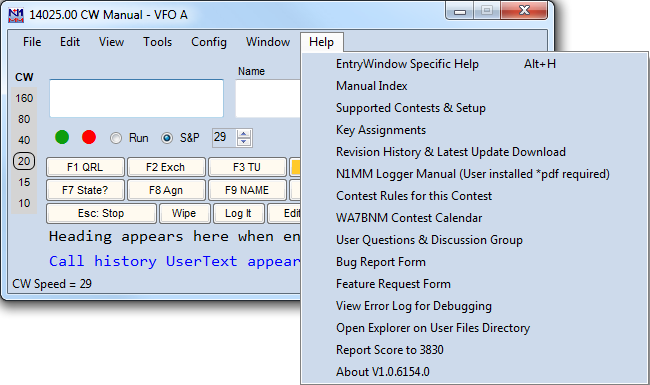

- #N1mm logger for cw keying for ft 897 software#
- #N1mm logger for cw keying for ft 897 mac#
- #N1mm logger for cw keying for ft 897 windows#
Want to go to 144.205? Just type in 144205 and you’re there. This is extremely useful when you’re moving stations onto new bands. Even better, just type in the frequency and mode where you’d normally type the call sign and presto change-o, you’re on the right frequency and mode. Just click the correct entry window or click on the band button on that window. The entry window setup also allows ready swaps between rigs and bands on those rigs. Just right click on the entry window and make the changes. The IC-9700 shows 2 meters and 70 cm, which are the two bands I use as a limited rover. The IC-7300 shows only 6 meters and 1.25 meters, which are the only two bands it operates in the contest, more about transverters later. Not only that but two rig control works perfectly.įor example, with my setup I have one entry window for the IC-7300 and one for the IC-9700. You can customize the list of bands to match your particular radio and the contest. However, look a little closer in the documentation and, outside of that flaw for rovers, you’ll find it is nearly perfect for VHF contesting and roving. Here’s why.

I had earlier investigated it and immediately rejected it since it doesn’t provide scoring for rover entries. What N1MM+ Offers the VHF Contesterįor the June Contest it looks like I’m going to put in play N1MM+ Logger.

That can be overcome by just selecting the band on VHF Contest Log and keying in the SSB/CW contacts, but it doesn’t record the exact frequency, only the band. What I didn’t like was the conflict inherent in attempting to control the rig by two different programs: WJST-X and the logger. What I liked about that setup was moving FT-8 and MSK144 QSOs directly into the master log. I’m working on those with shipments of ferrite beads headed my way. That worked great at home in my shack but had some serious RFI issues in the rover.

#N1mm logger for cw keying for ft 897 mac#
For scoring and generating a Cabrillo file, I drop the ADI file into VHF Contest Log.įor the January VHF contest I decided to skip the Mac entry and instead run VHF Contest Log along with JT-Alert and WJST-X in two instances - one for the IC-7300 and the other for the IC-9700. That setup gets the QSOs in a logbook but doesn’t generate a Cabrillo file nor does it flag dupes.
#N1mm logger for cw keying for ft 897 windows#
More recently I’ve used N3FJP’s VHF Contest Log as well as ACLog and some of their other HF contest logs. I run all these programs on an HP laptop with Windows 10.įor VHF Rover operation, I’ve generally used my MacBook Air and MacLoggerDX in contest mode teamed up with JT-Bridge and WSJT-X. Logging for VHF Roversīut I’ve also used N1MM primarily for HF RTTY contesting and the great integration it offers between decoding, transmitting, and getting the QSOs in the log. That has included Aether, RUMlog, RUMped, SkookumLogger, and my all time favorite MacLoggerDX (which also works seamlessly with MacDoppler for satellite QSOs). Over the years I’ve used a lot of different logging programs primarily in a mostly Apple environment here at home.
#N1mm logger for cw keying for ft 897 software#
After the January VHF contest I decided to explore logging software a bit further.


 0 kommentar(er)
0 kommentar(er)
